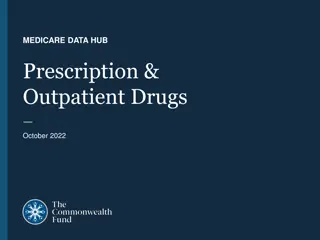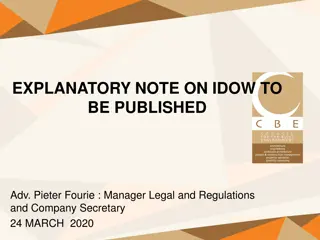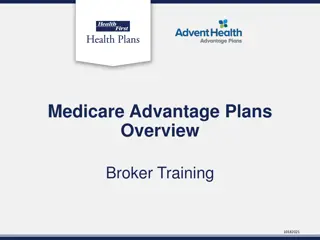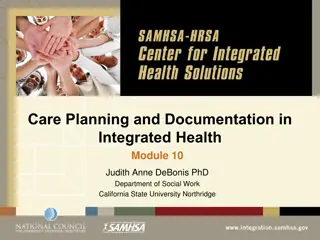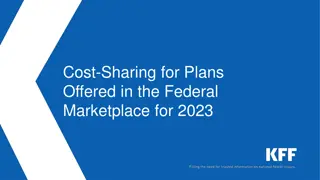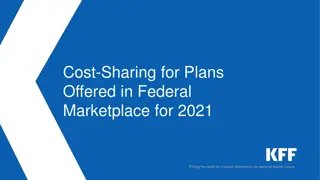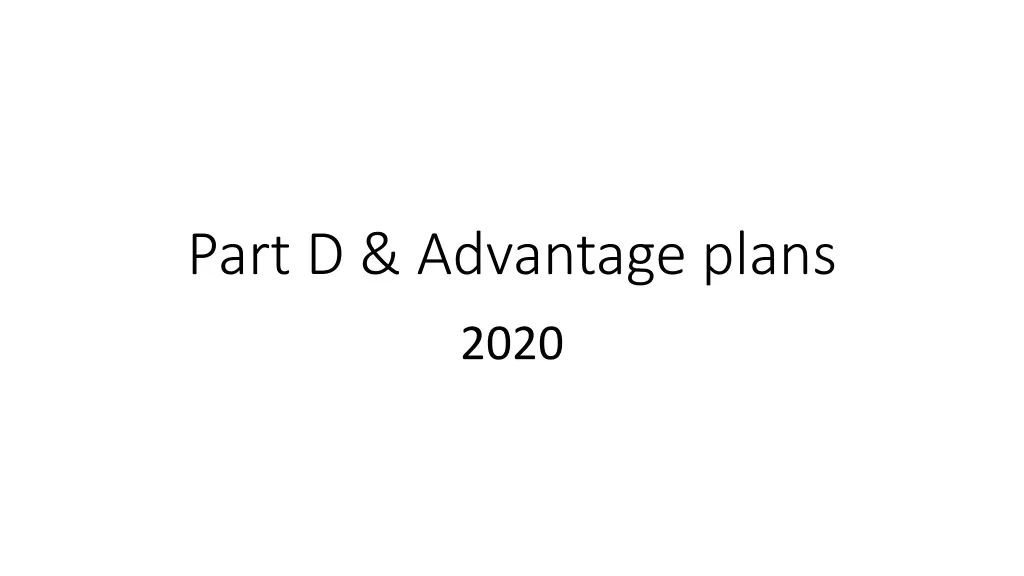
Part D and Advantage Plans 2020 Overview
Explore the latest information on Part D and Advantage plans for 2020, including parameters, copays, non-covered drugs, Part D vs. Part B drugs, and more. Discover low-cost plans, available Part D plans in Wisconsin, and understand what it means to be in a low-cost plan. Stay informed about plan renewals and automatic mappings for the next year.
Download Presentation

Please find below an Image/Link to download the presentation.
The content on the website is provided AS IS for your information and personal use only. It may not be sold, licensed, or shared on other websites without obtaining consent from the author. If you encounter any issues during the download, it is possible that the publisher has removed the file from their server.
You are allowed to download the files provided on this website for personal or commercial use, subject to the condition that they are used lawfully. All files are the property of their respective owners.
The content on the website is provided AS IS for your information and personal use only. It may not be sold, licensed, or shared on other websites without obtaining consent from the author.
E N D
Presentation Transcript
Part D non-covered drugs Off label drug use Drug not approved by FDA Cosmetic, weight loss, fertility, ED OTC cold and flu meds (Rx cough meds)
Part D vs Part B drugs Oral anti-cancer meds Anti-rejection meds Shots given into muscle tissue or IV (given by nurse) Certain vaccines
CY 2020 MA Non CY 2020 MA Non- -Renewal by State/County Renewal by State/County and Plan Type and Plan Type HMOPO S Local PPO Regional PPO MA- Only State County Total HMO PFFS MSA MA-PD US Total 206,348 56,601 3,868 142,476 3,094 309 0 2,375 203,973 WI Calumet * * * WI Jefferson * * 0 * WI Rock * * 0 * WI Rusk 125 125 125 WI Total 132 0 * 0 125 0 0 0 132
9 Low-Cost (or benchmark) Part D plans Cigna Health Spring Rx Secure Cigna Spring Health Value Rx Envision Rx Plus Express Scripts Medicare Value Humana Basic Rx Plan SilverScript Choice AARP Medicare Rx Saver Plus WellCare Classic WellCare Medicare Rx Saver
29 Part D plans for WI in 2020 Premiums range from $13.20 to $124.00 WI has highest benchmark for Part D plans.
What does being in a low What does being in a low- -cost plan mean cost plan mean? A person with LIS will not have to pay a premium by being enrolled in a low- cost plan. You cannot simply look at the dollar amount of a plan premium to know if it s low cost. Plans must be designated as low cost plans with CMS. A person on LIS does NOT need to be in low-cost plan. They can choose a more expensive plan and pay the difference (will not be a dollar for dollar difference). Auto-enrollments into low cost plans are totally random.
Mapping Automatically moved into a different plan for the next year Not entitled to the Non-Renewal Plan SEP Aetna Part D enrollees will be mapped into WellCare Part D plans for 2020
Mapping Enrollee can always override the mapping and make own selection (recommended) Enrollee should have received 2 notices in advance of the mapping Premiums, coverage, formulary, pricing may be quite different
Non-Renewal SEP SEP runs December 8 through February 28 Applies to any plans that will not return in 2020 or leaving the Wisconsin market: Enrollees in plans not renewing means that enrollees must enroll themselves in a new plan for 2020 during the AEP (October 15th December 7th) if they want coverage in 2020. If enrollees fail to enroll in a new plan during the AEP they have an additional opportunity to do so from December 8, 2019 through February 28, 2020 by way of the nonrenewal SEP. Coverage will start the first of the month following the month of enrollment.
Non-Renewal SEP The SEP continues for 2 months after their plan terminates. If they wait until January or February to enroll, they will have a 1 or 2 month gap in coverage.
Adv plan leaving at end of year Triggers GI into a supplement for 63 days! Person MUST stay in the Adv plan until December 31 Don t jump ship early! If cost plans leave, this would also trigger GI.
MSA Combines a high deductible plan & bank account (bank chosen by plan). Medicare deposits money into a savings account to use for services. Beneficiary stays in plan for whole year limited SEP situations ( locked in ). Works like a PFFS plan go anywhere that will accept you. Not the same network as Original Medicare (some insur. agents are misinformed, telling beneficiaries incorrect info) Can rollover savings account to the next year for future qualifying health expenses. MSAs do NOT include drug coverage. They are a PFFS plan which means a person can (must) purchase stand-alone Part D plan with it.
Not eligible for MSA Person who has health coverage that would cover the MSA plan deductible employer or retiree coverage. Person with benefits from Dept. of Defense (TriCare) or the VA. Retired federal government employee (FEHB). Person eligible for Medicaid Person with ESRD Person on hospice care (who has elected hospice benefits under Medicare) Person that lives outside U.S. more than 183 days a year. People on LIS or Medicare Savings Programs (QMB, SLMB, SLMB+)
MSA SEPs Must do enrollment/disenrollment during AEP Exceptions: MOVE Eligibility for LIS, Medicaid, MSP Person will have to pay back a pro-rated amount of the deposit!
BSSA reminders Use the Disclaimer letter If retaining a client login and password, be sure to have form signed and keep copy in file Print out enrollment confirmations if you helped the person enroll
Reminders People turning 65 during the fall (during AEP) No LIS 4thquarter SEP (all LIS people must make elections by 12/7/19) Multiple enrollments okay if the person changes their mind Non-renewal SEP: must make a plan choice by 12/31/19 for January coverage. SHIP counselor error (keep printouts of enrollments as confirmation)
SeniorCare and TrOOP True Out of Pocket expenses: expenses that count toward a person s Medicare Part D out-of-pocket threshold of $6,350 (the 2020 True Out of Pocket threshold). SeniorCare Level 1 or 2a: Only what the member pays counts toward Part D TrOOP SeniorCare Level 2b or 3: Both the payments issued by SeniorCare and the member are applied to the TrOOP amount.
State Pharmaceutical Assistance Program (SPAP) Only Parts 2b and 3 of SeniorCare qualify as a SPAP See definition of SPAP in federal statute 42 CFR 423.464 SeniorCare Parts 1 and 2a do not meet the criteria for a SPAP excluded because they draw down federal Medicaid matching funds (a section 1115 demonstration program).
Enrollment into SeniorCare Can Generate a Special Enrollment Period
State Pharmaceutical State Pharmaceutical Asst Asst Program (SPAP) SEP Program (SPAP) SEP Levels 2b & 3 only Allows enrollment into a new plan or to change between plans Enrollment into new plan typically drops old plan automatically Exceptions: (cost plans, PFFS plans)
Other creditable coverage SEP Other creditable coverage SEP Any level of SrCare One way pass OUT of a Part D plan or Advantage plan with Rx Does not allow a change of plan or enrollment into a new plan
SeniorCare PROS Easy to use Works alone or with Part D Creditable coverage Low copays & annual fee No coverage gap Counts towards TROOP CONS Does not cover diabetic supplies, i.e. syringes (unless pre-filled) Vaccines are not covered Does not work if on Medicaid People on Medicare Savings Program (MSP) must have Part D as primary No out-of-network coverage: Out of state Hospital observational stay/ER
Non-covered medications Vaccines Prescription drugs administered in a dr s office Drugs that are experimental or cosmetic OTC drugs such as vitamins and aspirin, even if prescribed by dr except for insulin Prescription drugs for which prior authorization has been denied. Brand name drugs unless medically necessary (per dr) Drugs from manufacturers who have not signed a rebate agreement with the state.
CAUTION Certain people must enroll in a Part D plan as primary to SrCare SeniorCare will not work without a Part D plan if the person is deemed eligible for LIS due to being in a Medicare Savings Program (QMB, SLMB, or SLMB+). SeniorCare remains in place, just requires a primary payer to be billed These cases apparently show up as quasi-Medicaid in the SeniorCare computer system.
CAUTION No drug coverage for out-of-network claims: Emergency room or hospital observational status Most hospital inpatient pharmacies are not in-network No coverage out of state No self-submission of claims
Retroactive Medicaid (Dual Eligibles) A person is not eligible for SeniorCare if on Medicaid Card services LTC Medicaid Medicaid applications may take months to process & be approved Medicaid is often approved retroactively Person is then dis-enrolled retroactively from SrCare Must utilize LINET for drug coverage Should be auto-enrolled into a Part D plan going forward
Retroactive Medicaid (Dual Eligibles) LINET will not work in the following situations: Person opted out of Medicare auto-enrollment Person is already enrolled in a Part D plan Person has employer/retiree coverage Person is in Advantage plan w/o drug coverage CMS Region V (retroactive dis-enrollment from Adv plan or to MA-PD plan) SHIP counselor designation required
SeniorCare FAQs Q: Does SrCare cover Novolog that is used in an insulin pump? A: Yes
SeniorCare FAQs Q: What if my income was slightly higher than I expected and put on my annual application? A: Annual income is determined prospectively from the month of application through the next 12 calendar months. (Good faith, best estimate.)
SeniorCare FAQs Q: What if I retire mid-year and my income is much less than I anticipated? A: A person can submit a new application and $30 fee at anytime to re- establish a new benefit category. Hint: you would only want to do this if you would go down to a lower level of SeniorCare
SeniorCare FAQs Q: If my spouse moved to a NH, do I still have to include his income in my application? A: SeniorCare counts the income of both spouses if they live together. Exceptions: One spouse in a NH and expected to remain there for > 30 days, Both spouses are in a NH; Married, but living separately; or Applicant s spouse is on SSI.
Summary SeniorCare: is creditable coverage can either be used by itself or with Part D coordinates well with Part D does not coordinate with Medicaid works in nursing homes if pharmacy accepts SeniorCare, and if person is not on Medicaid.
SeniorCare resources Medicaid Eligibility Handbook section 33 http://www.emhandbooks.wisconsin.gov/meh-ebd/meh.htm WI DHS SeniorCare page and link to application https://www.dhs.wisconsin.gov/seniorcare/index.htm WI SeniorCare customer service number 1-800-657-2038
Adv plans for 2020 Premiums Are coinsurance, copays, and OOP costs ?
Of the nations $3.3 trillion in annual health care spending, 90% stems from people with chronic or mental health conditions, according to the Centers for Disease Control and Prevention.
2019 Adv plans--history Adv plans could offer supplemental benefits Had to offer same benefits to all enrollees at same cost WI did not have any of these plans in 2019
Supplemental benefits for chronically ill Chronically ill: One or more co-morbidities or chronic conditions High risk of hospitalization or bad outcomes Intensive care coordination
2020 Adv planssupplement benefits Services provided by a plan or other 3rd party *Up to the plan to decide what benefits the individual will receive
2020 Adv planssupplement benefits Bipartisan Budget Act Special supplemental benefits for chronically ill Add l benefits or reduced cost sharing for covered services Does NOT have to be medical-related Benefits NOT given to all people, not even all people with the same condition Benefits will be specific to the individual & their support needs
Examples of supp benefits for chronically ill Home-delivered meals Non-medical transport Pest control Indoor air quality equip Social needs benefits Complementary therapies Structural home modifications Supports for living
2020 Adv planssupplement benefits Everyone still pays the same premium Cannot target people based on socio-economic status Plan may require people to participate in care management program Plans cannot mislead/misrepresent supplemental benefits Advertising on the PF (looks like available to all enrollees) Not guaranteed enrollee will receive them Individualized assessment of person s needs





